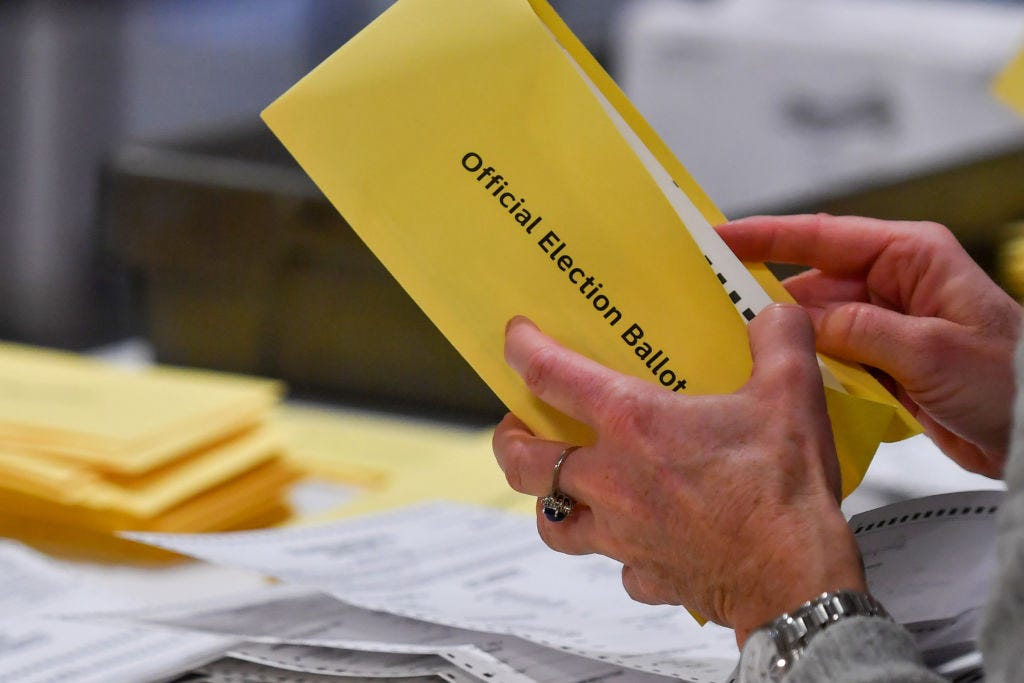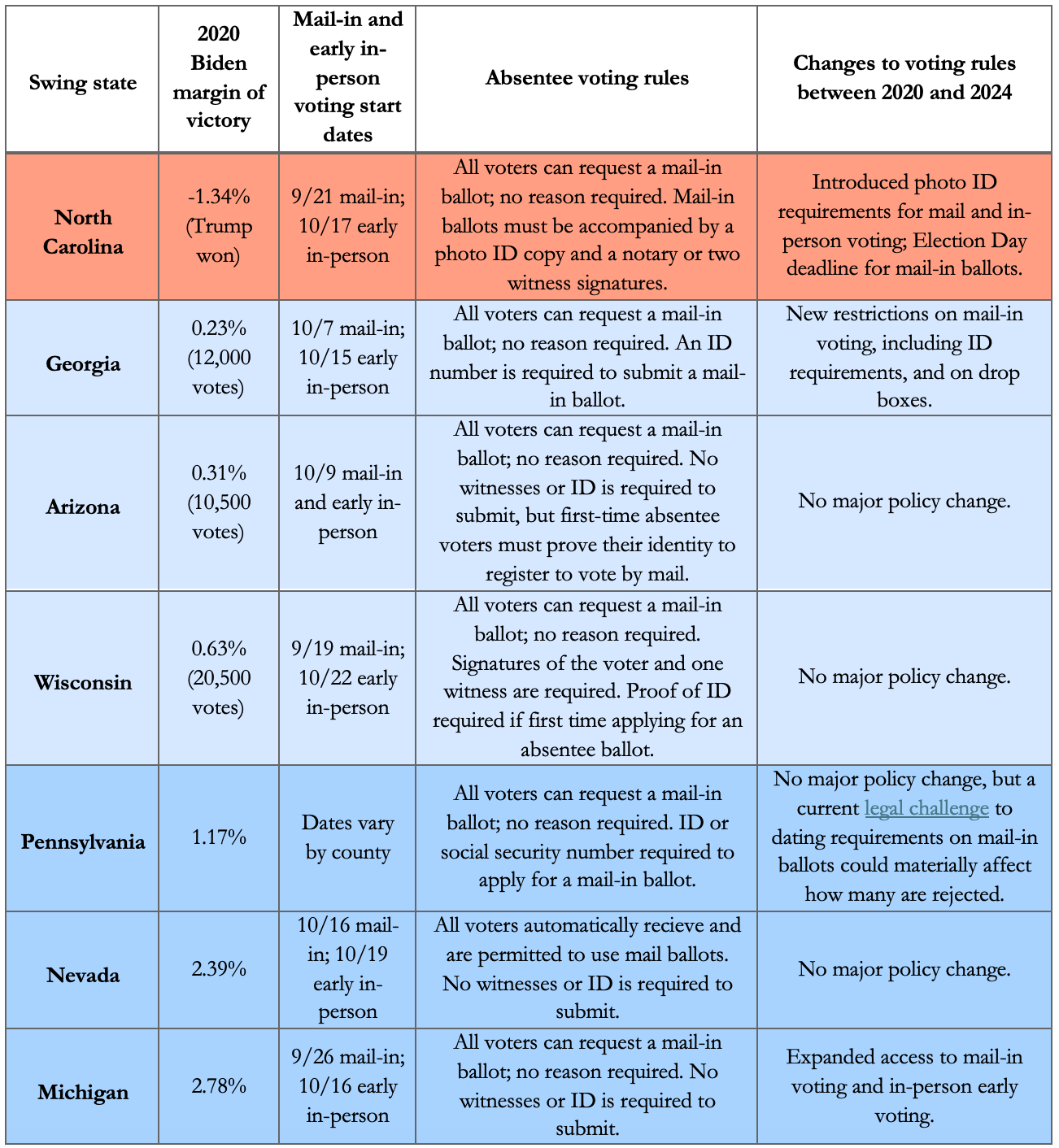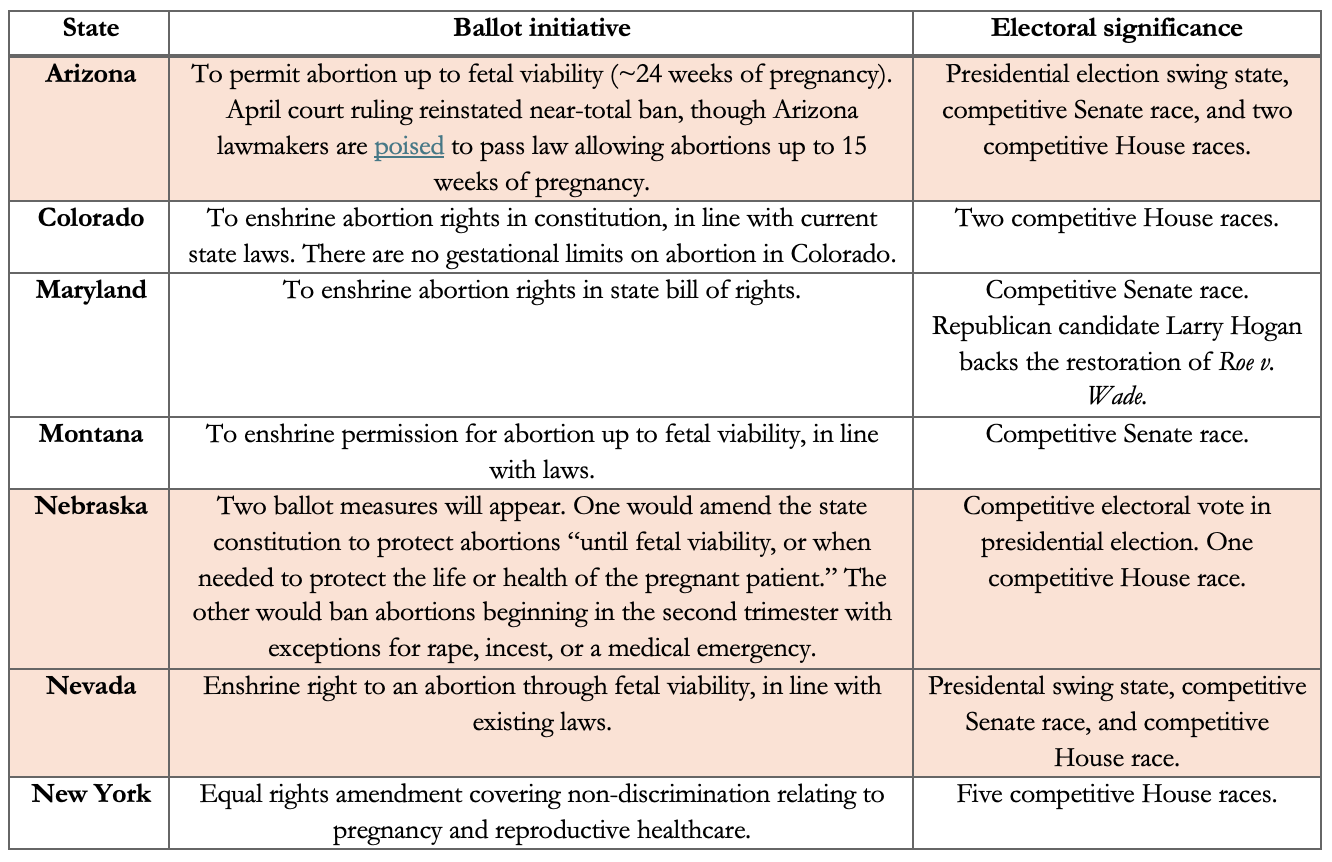The Power of the Party
Examining the relative institutional strengths of Republicans and Democrats heading into November.

President Joe Biden’s 2020 election victory was decided by just 123,000 votes across four key swing states: Georgia (which Biden won by 0.2 percent), Arizona (+0.3 percent Biden), Wisconsin (+0.7 percent Biden), and Pennsylvania (+1.2 percent). In Arizona, Biden won by a grand total of 10,500 votes—the narrowest margin of any state.
Current polling suggests the 2024 election will be another nail-biter.
Though Vice President Kamala Harris leads former President Donald Trump by several points in national polls, most experts believe that Republicans will have an Electoral College advantage. As in 2016 or 2020, they posit that Democrats will over-perform in deep-blue states like California and New York (so-called “wasted” votes) while Trump will over-perform among white working-class voters in the Rust Belt who are likely to decide the election. A small Democratic lead thus suggests a toss-up election.
In the search for clues as to how such a race may end, 20th-century elections provide a rather unhelpful model. Presidential elections post-2000 sharply contrast with earlier elections, when landslides such as Ronald Reagan’s crushing defeat over Walter Mondale in 1984 or Lyndon B. Johnson’s dominant victory over Barry Goldwater in 1964 were not unusual. Since the national popular vote was first tallied in the nineteenth century, there have only been two elections where the winner of the Electoral College lost the popular vote (1876, 1888) but two such instances in the past twenty-four years (2000, 2016).
A better historical analogy for today is the “Third Party System,” a period of high political polarization and tightly contested elections that began in the 1850s and ended with William McKinley’s victory in 1896.
Third Party System elections were intensely partisan and marked by high turnout. Then, party machinery—the permanent party infrastructure used to turn out base voters and suppress the opposition—was key to winning.
In a controversial decision at the time, Republicans backed mail-in voting in 1864 to turn out Union soldiers fighting the Civil War and thus aid President Abraham Lincoln’s re-election effort. States largely approved absentee voting for soldiers along partisan lines. Urban party machinery likewise doled out spoils to party loyalists. Redistricting became increasingly important in determining House control, which swung wildly. Parties manufactured and issued partisan paper ballots that made it difficult for voters to split their ticket. Voter suppression and intimidation, bribery, and genuine electoral fraud were common.
Though Republicans have an Electoral College advantage today, so-called “Institutional Democrats” have a different advantage: they have proven more adept than Republicans in their organization. This is evident in at least three different ways for the Democrats: (1) their ability to neutralize third-party candidates, mostly nullifying what some analysts last year projected could be a major disadvantage for Democrats against Trump; (2) their decision to associate themselves with abortion-related ballot measures that favor their party; and (3) their work to turn out the vote via early and mail-in votes.
Third-party candidates
In a close election, both campaigns recognize that they cannot afford to lose votes to third-party candidates.
Independent candidate Robert F. Kennedy, Jr. has by far appeared the most viable of the third-party candidates running in the 2024, surprising many by gaining ballot access in key swing states. Internal Trump polling found that Kennedy pulled significantly more support from Trump than Harris in most swing states.
Kennedy subsequently dropped out of the presidential race and endorsed Trump at the latter’s urging.
His decision came too late in three of the seven projected swing states. Wisconsin and Michigan confirmed that Kennedy would still be on their ballot. Though Kennedy has suspended his campaign, he is likely still to attract some votes—and it may come at Trump’s expense. Kennedy voters in Wisconsin break for Trump by 30 points or more when forced to choose between Trump and Harris. They break about evenly in Michigan.
On the Democratic side, party luminaries such as Bill and Hillary Clinton and Democratic organizations like Third Way waged a concerted effort to ensure No Labels backed down from their promise to run a national “unity” presidential ticket. The Democratic National Committee and others have since waged court battles to block the remaining third-party candidates from being listed as an option on states’ ballots.
Outside of Kennedy, three third-party candidates remain who register between one to two percent support in the polls: Green Party candidate Jill Stein, Libertarian candidate Chase Oliver, and independent candidate Cornel West. Loosely, Stein and West tend to appeal to left-leaning voters while Libertarian Party candidates appeal more to right-leaning ones.
At this point, Stein and Oliver will appear on the ballot in at least six of the seven swing states; independent West is slated to appear in four.
Third-party candidates historically poll worse as the election approaches, then underperform final polls on Election Day. The 2024 election is therefore poised to look much like 2020, another cycle when third-party candidates had little effect.
Abortion-related ballot initiatives
On the campaign trail, Harris and down-ballot Democratic candidates have advocated for ballot measures to increase abortion access, associating their candidacies with the cause of protecting reproductive rights.
Despite some analysts’ predictions of a “red wave” in the 2022 midterm elections, Democrats held the Senate and barely lost the House. Ballot initiatives in swing states or districts that enshrined abortion rights in state constitutions after the Supreme Court overturned Roe v. Wade in June were one key reason why. In Michigan, a competitive state with an abortion-related ballot initiative, Democrats swept statewide races and won unified control of the state legislature.
This cycle, abortion-related ballot initiatives will appear on ten states’ ballots, including three competitive Electoral College states: Arizona, Nevada, and Nebraska (where candidates will be competing for NE-02’s lone electoral vote).
Abortion-Related Ballot Initiatives in Key States*
There is recent historical precedent showing that ballot measures can help a party at the top of the ticket. In 2004, an initiative banning same-sex marriage in Ohio may have decided the presidential election for incumbent George W. Bush over John Kerry by boosting turnout among evangelicals.
Ohio was the tipping-point state in 2004, which Bush won with just 286 electoral votes to Kerry’s 251 votes. Kerry lost the state by just 118,000 votes, or a 2.1-point margin.
Abortion referenda could do the same in closely matched contests in Arizona, Nevada, or Nebraska’s 2nd congressional district.
Early and mail-in voting
Trump has long railed against mail-in and early voting. During the 2020 campaign, he argued: “There is fraud; they found [ballots] in creeks, they found them with the name Trump in a wastepaper basket...this will be fraud like you have never seen.”
He has since changed his tune, at his campaign’s urging, now saying that absentee, early, and Election Day voting “are all good options.”
GOP strategists, as well as Trump’s own campaign managers, recognize that his campaign against accessible voting methods decreases Republican turnout and hurts Republican candidates. Both voting methods (and “ballot harvesting,” the related practice of outside organizations collecting filled-out absentee ballots from voters) increase turnout by increasing opportunities for voters to cast ballots.
Driven by Covid, mail-in voting ramped up during the 2020 presidential election—especially among Democratic voters—reflecting 43 percent of the total vote share. In the 2022 midterm elections, the share of mail-in votes declined but remained substantially higher than 2016. That year, Democrats and Republicans voted by mail at around the same rate; now, Democrats have amassed a huge advantage.
Democrats retained a strong vote-by-mail advantage in the 2022 midterm elections, suggesting the scarring effects of Trump’s rhetoric may prove difficult for Republicans to undo. Still, they now clearly see it in their interest to try. Their strategy to cut into Democrats’ advantage is two-pronged.
First, and prior to Trump’s blessing of mail-in and early voting efforts this spring, Republican-controlled state legislatures passed restrictions on early and mail-in voting in swing states North Carolina and Georgia. Democrats in Michigan, meanwhile, expanded access to early and mail-in voting.
Second, the Trump campaign began an early and mail-in voting campaign, “Swamp the Vote,” to help potential voters check their voting registration and request mail-in ballots. Their efforts, which only began late this spring, are specifically targeted at historically left-leaning groups that have trended conservative, such as nonwhite male voters.
Though the GOP would like to cut into Democrats’ advantage, its two-pronged strategy could contradict itself. If the GOP successfully expands vote-by-mail, new restrictions in North Carolina and Georgia could cut into the party’s own vote share.
Swing-State Election Laws*

Mail-in voting has already begun in Wisconsin and North Carolina.
Republicans could retain an Electoral College polling advantage this election cycle. But that is not guaranteed; nor is it the whole ballgame in a tightly decided election. Institutional Democrats have the advantage or have neutralized threats in three areas that may help decide the presidential election on the margins: minimizing the impact of third-party candidates that could take votes from their candidate; associating themselves with ballot initiatives that grant abortion access; and boosting early and mail-in voting.
Given a slim lead, whether a candidate wins the election may come down to his or her political operation.
Ava Kelley is the U.S. Director at Greenmantle, a macroeconomic and geopolitical advisory firm.







1) A great book to consider, Paul Kleppner's "Cross of Culture," where he argued that ALL elections from 1876 to 1900 were decided by a handful of swing counties in the midwest, almost entirely based on religion (and not "Catholic v. Protestant" but shades of Lutheranism, etc.
2) Early vote share has risen. Democrats lead---BUT a) the requested VBM ballots are way, way down. In some cases, 80% off 2020; on average, at least 30%; and b) the Democrats share has fallen sharply (at least 11 points in NC, PA, Duval Co. FL., while the GOP share has risen significantly (about 5-7 points on average, making for a 11-19 point swing in these states. When combined with the massive decline in early vote, which makes cheating and fraud nearly impossible, and the changed shares, Republicans have essentially already "won" the early vote.
For example, I recall in 2020 closely watching FL and the early vote. We calculated that to win FL, Obama had to come out of FL with a 111,000 early vote lead. He didn't make it. When we saw he only had a lead of 77,000 we knew the R had won.
3) VA is a totally different matter, equally if not more, encouraging for Rs. Turnout was high in Fairfax, yes, but it was off the charts in the red counties. Three or four hit their 2020 total in the FIRST DAY. Buchanan and others were already at 85%, meaning Rs will come out of VA early voting with a 20 point improvement over 2020.. Here's the kicker---and Ruy, you didn't address registrations much, but I think they are THE telling stat. We con't know VA registrations because VA dose not register by party, but based on trends in 30/30 other states and nearby NC, OH, etc., it's more than a good bet that VA voter registrations have stunningly moved right. When THAT factor is applied, Virginia is MORE than "in play."
4) Last but not least, Maricopa Co. AZ continues to just explode red. Yesterday's R lead was up to 163,800 while Yavapai came in with an R lead of 59,000. AZ is on a pace to finish at R+7 by November. AZ is NOT "in play," nor is NC, whose early vote margin for Ds, along with VBM requests are way, way down from 2020. Same with PA. I said last week that based on voter reg and early ballot requests, Trump had won the election. Now Bernie Moreno leads in the OH senate (remember they always underpoll Trump there by 4 at least, so Moreno is probably up more, meaning the GOP will likely end up at least 52-48 in the senate. We'll see if I'm right!